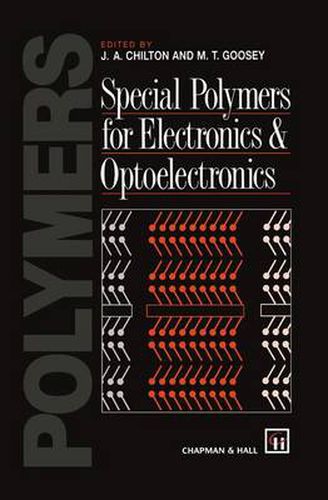Readings Newsletter
Become a Readings Member to make your shopping experience even easier.
Sign in or sign up for free!
You’re not far away from qualifying for FREE standard shipping within Australia
You’ve qualified for FREE standard shipping within Australia
The cart is loading…






This title is printed to order. This book may have been self-published. If so, we cannot guarantee the quality of the content. In the main most books will have gone through the editing process however some may not. We therefore suggest that you be aware of this before ordering this book. If in doubt check either the author or publisher’s details as we are unable to accept any returns unless they are faulty. Please contact us if you have any questions.
For many years polymers have been widely used in all sectors of the electronics industry mainly for their insulating properties. However, in recent years a large number of other applications for polymers in electronics has evolved, for instance, the development of photoresists capable of creating sub-micron-sized features in semi-conductor wafer fabrication. The principle reason why polymers find wide application in electronics is that they are good dielectric materials with readily controllable properties. More recently many polymers have been developed which have intrinsic properties that make them of special interest in advanced electronics applications, such as the development of intrinsically conducting polymers. This book outlines some of the more recent developments in the chemistry, formulation and application of polymers and their composites in the electronic and optoelectronic industries. As well as discussing the present position in a wide area of applications, introductory information is included in each chapter, to help the reader entering a particular area for the first time.
Special Polymers for Electronics and Optoelectronics should be of interest to those working with electronic materials in both universities and the electronics industry, and to academics and industrial R&D working with electronic materials and polymers.
$9.00 standard shipping within Australia
FREE standard shipping within Australia for orders over $100.00
Express & International shipping calculated at checkout
This title is printed to order. This book may have been self-published. If so, we cannot guarantee the quality of the content. In the main most books will have gone through the editing process however some may not. We therefore suggest that you be aware of this before ordering this book. If in doubt check either the author or publisher’s details as we are unable to accept any returns unless they are faulty. Please contact us if you have any questions.
For many years polymers have been widely used in all sectors of the electronics industry mainly for their insulating properties. However, in recent years a large number of other applications for polymers in electronics has evolved, for instance, the development of photoresists capable of creating sub-micron-sized features in semi-conductor wafer fabrication. The principle reason why polymers find wide application in electronics is that they are good dielectric materials with readily controllable properties. More recently many polymers have been developed which have intrinsic properties that make them of special interest in advanced electronics applications, such as the development of intrinsically conducting polymers. This book outlines some of the more recent developments in the chemistry, formulation and application of polymers and their composites in the electronic and optoelectronic industries. As well as discussing the present position in a wide area of applications, introductory information is included in each chapter, to help the reader entering a particular area for the first time.
Special Polymers for Electronics and Optoelectronics should be of interest to those working with electronic materials in both universities and the electronics industry, and to academics and industrial R&D working with electronic materials and polymers.